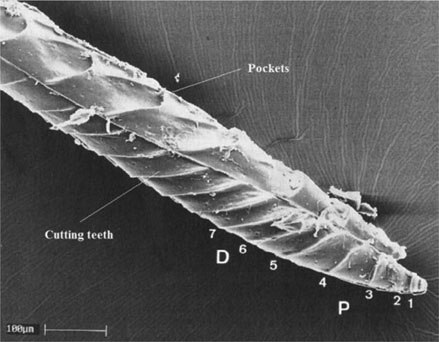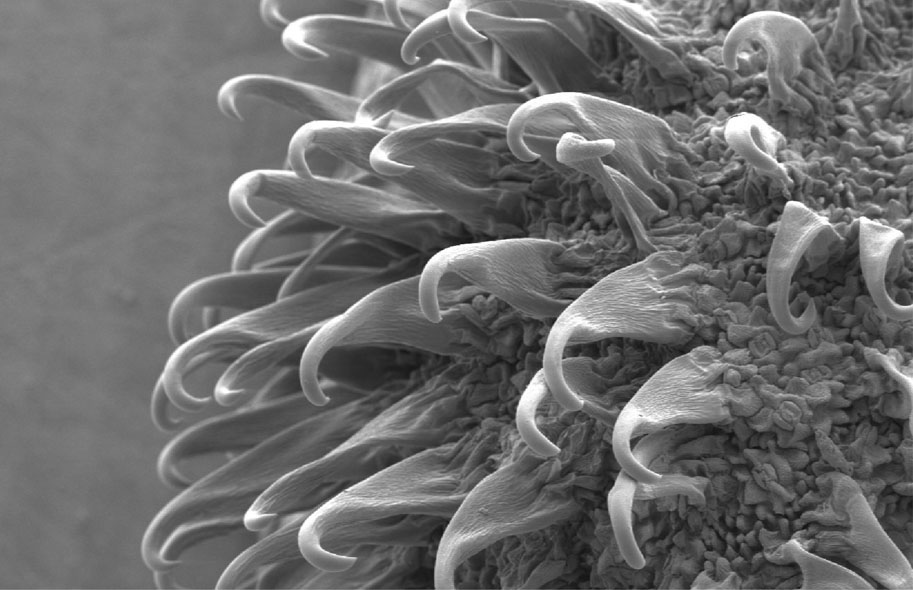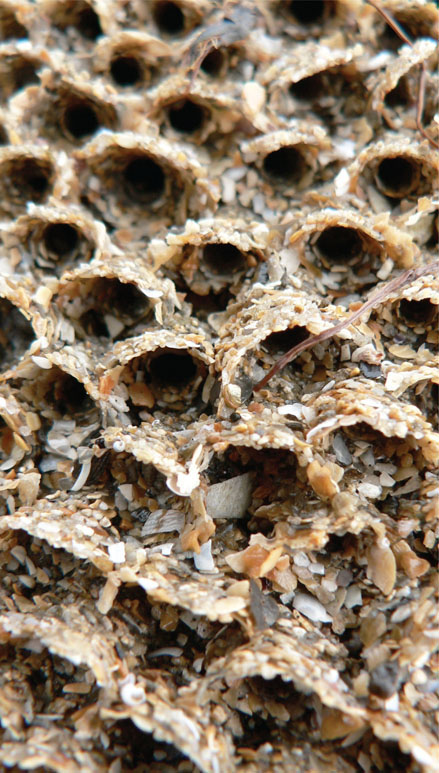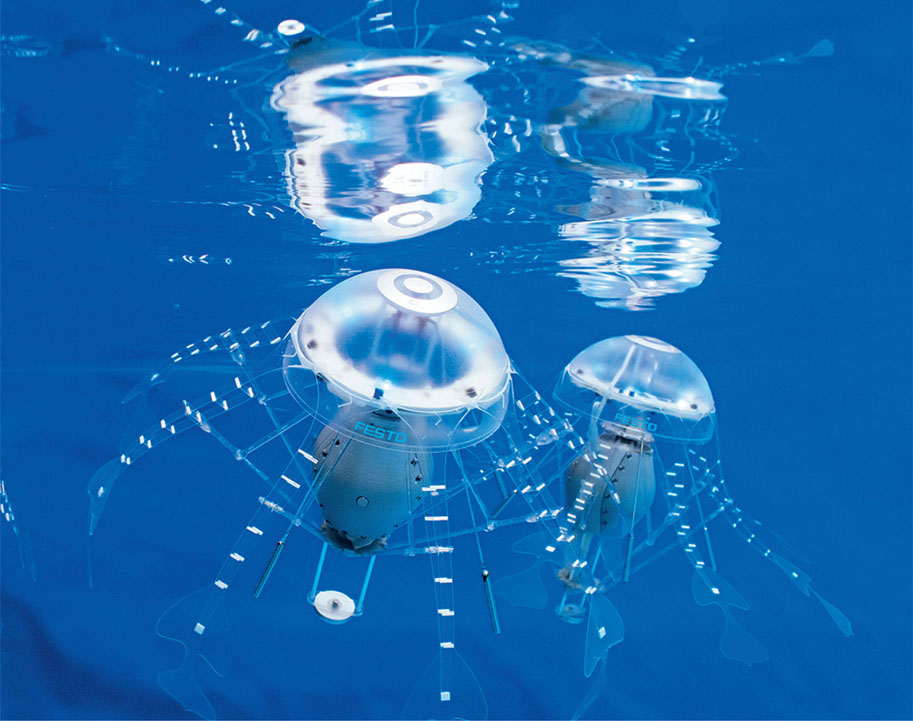Introduction

1.
Coccolithophores (marine micro-organisms) make their skeletons from calcium carbonate using elements in seawater and are thought to be part of the planet’s long-term carbon cycle. In geological periods when carbon dioxide levels in the atmosphere rose, coccolithophores bloomed and, when they died, fell to the ocean floor to form layers of limestone, so transferring carbon from the atmosphere to the lithosphere. The challenge facing humanity now is that the rate of carbon dioxide increase is far in excess of anything that has previously occurred in the history of the planet and beyond a level that can be controlled by correcting mechanisms such as coccolithophores
What do we need to do to achieve true sustainability? Will incremental efficiency improvements and mitigation of negative impacts be enough? Or do we need to set more ambitious aims for the grand project of humanity? What I will argue in this book is that biomimicry – design inspired by the way functional challenges have been solved in biology – is one of the best sources of solutions that will allow us to create a positive future and make the shift from the industrial age to the ecological age of humankind. The latter, in my view, is not only eminently possible; we already have nearly all the solutions we need to achieve it.
If biomimicry increasingly shapes the built environment – and I feel it must – then, over the next few decades, we can create cities that are healthy for their occupants and regenerative to their hinterlands, buildings that use a fraction of the resources and are a pleasure to work or live in, and infrastructure that becomes integrated with natural systems. Thousands of years of human culture can continue to flourish only if we can learn to live in balance with the biosphere. This is not a romantic allusion to some intangible Arcadia; what I describe in this book is a route map based on scientific rigour that can be translated by the human imagination into a tangible reality.
For me, there is no better mission statement than Buckminster Fuller’s: ‘To make the world work for a hundred percent of humanity, in the shortest possible time, through spontaneous cooperation, without ecological offense or the disadvantage of anyone.’1 How do we achieve this? There are, I believe, three major changes that we need to bring about: achieving radical increases in resource efficiency,2 shifting from a fossil-fuel economy to a solar economy and transforming from a linear, wasteful way of using resources to a completely closed-loop model in which all resources are stewarded in cycles and nothing is lost as waste. Challenging goals, but if we choose to embark on these linked journeys then there is, in my opinion, no better discipline than biomimicry to help reveal many of the solutions that we need.
Biomimicry in Architecture is a book all about that rich source of solutions, and this new edition reflects the changing state of the art. Biomimicry involves learning from a source of ideas that has benefitted from a 3.8-billion-year research and development period. That source is the vast array of species that inhabit the earth and represent evolutionary success stories. Biological organisms can be seen as embodying technologies that are equivalent to those invented by humans, and in many cases have solved the same problems with a far greater economy of means. Humans have achieved some truly remarkable things, such as modern medicine and the digital revolution, but when one sees some of the extraordinary adaptations that have evolved in natural organisms, it is hard not to feel a sense of humility about how much we still have to learn.
Why is now the right moment for biomimicry? While fascination with nature undoubtedly goes back as long as human existence itself, now we can revisit the advances in biology with the massive advantages of expanding scientific knowledge, previously unimaginable digital design tools and aesthetic sensibilities that are less constrained by stylistic convention. Designers have never had such an opportunity to rethink and contribute to people’s quality of life, while simultaneously restoring our relationship with our home – the home that Buckminster Fuller called ‘spaceship earth’.3
It is true to say that biology proceeds by tinkering (to use Francois Jacob’s term4) with what already exists, consequently producing some undeniably suboptimal solutions,5 whereas human invention is capable of completely original creation. The great asset that biology offers is aeons of evolutionary refinement. Biomimicry is neither thesis nor antithesis. At its best, biomimicry is a synthesis of the human potential for innovation coupled with the best that biology can offer.6 This synthesis exceeds the power of either alone.
This book describes the extent of solutions available in biomimicry, how architects are currently implementing those solutions, and the breadth of scale over which biomimicry is applicable. The book closes with a guide to working effectively with biomimicry and how to deliver the buildings and cities we need for the ecological age.
What is biomimicry?
Throughout history, architects have looked to nature for inspiration for building forms and approaches to decoration: nature is used mainly as an aesthetic sourcebook. Biomimicry is concerned with functional solutions, and is not necessarily an aesthetic position. The intention of this book is to study ways of translating adaptations in biology into solutions in architecture.
The term ‘biomimicry’ first appeared in scientific literature in 1962,7 and grew in usage particularly among materials scientists in the 1980s. The term ‘biomimicry’ was preceded by ‘biomimetics’, which was first used by Otto Schmitt in the 1950s, and by ‘bionics’, which was coined by Jack Steele in 1960.8 There has been an enormous surge of interest during the past 15 years, driven by influential and extensively published figures like biological sciences writer Janine Benyus,
Professor of Biology Steven Vogel and Professor of Biomimetics Julian Vincent. Julian Vincent defines the discipline as ‘the implementation of good design based on nature’,9 while for Janine Benyus it is ‘the conscious emulation of nature’s genius’.10 The only significant difference between ‘biomimetics’ and ‘biomimicry’ is that many users of the latter intend it to be specifically focused on developing sustainable solutions, whereas the former is often applied to fields of endeavour such as military technology. I will be using biomimicry and biomimetics as essentially synonymous.
Since the publication of the first edition of this book, definitions in this field have moved on considerably, including the use of ‘bio-inspired design’ or ‘biodesign’ rather than ‘biomimicry’ or ‘biomimetics’. ‘Biodesign’ emerged as a term partly in the medical world (inventing and implementing new biomedical technologies), partly in robotics, and partly as a broad definition (which formed the title of a book and an exhibition by William Myers11) encompassing a range of design disciplines based on biology. The point being asserted in adopting a new term is that both ‘biomimicry’ and ‘biomimetic’ imply copying, whereas ‘bio-inspired’ is intended to include the potential for developing something beyond what exists in biology. I adopt the term ‘biomimicry’ because ‘bio-inspired architecture’ suggests a very broad definition – including everything from superficial mimicking of form all the way through to a scientific understanding of function and how that can inspire innovation. I find ‘bio-inspired engineering’ less problematic because ‘engineering’ implies functional rigour. No term will perfectly capture what we are doing and, as with any negotiations, it is more important to agree on common ground that unites the disciplines – being trans-disciplinary, evidence-based, focused on function and directed towards delivering transformative change12 – rather than battling over fine distinctions that divide them. Biomimicry and biomimetics are now widely understood as functionally based approaches. I’m not aware of anyone in the field who restricts themselves to only those solutions that exist in nature, so I am not particularly troubled by the asserted associations of ‘mimicry’. Time will tell which proves to be the most widely accepted term in an architectural design context. There are some other terms that are worth clarifying: ‘biophilia’, ‘biomorphic’, ‘bio-utilisation’ and ‘synthetic biology’. ‘Biophilia’ was a term popularised by the biologist E. O. Wilson13 and refers to a hypothesis that there is an instinctive bond between human beings and other living organisms. ‘Biomorphic’ is generally understood to mean design based on biological forms. ‘Bio-utilisation’ refers to the direct use of nature for beneficial purposes, such as incorporating planting in and around buildings to produce evaporative cooling. We will see later in Chapter 3 that this approach has a major role to play in biomimetic systems thinking. ‘Synthetic biology’ refers to the design and fabrication of living components and systems that do not already exist in the natural world and the redesign and fabrication of existing living systems. The key distinction between biomimicry and synthetic biology is that the former is not currently trying to create living components.

From an architectural perspective, there is an important distinction to be made between ‘biomimicry’ and ‘biomorphism’. Twentieth-century architects have frequently used nature as a source for unconventional forms and for symbolic association. Biomorphism has produced majestic works of architectural form, such as Eero Saarinen’s TWA terminal (fig. 2), and was used to great symbolic effect by Le Corbusier (fig. 3). But, in contrast, biomimicry is concerned with the way in which functions are delivered in biology. The distinction is important because we require a functional revolution of sorts, and I firmly believe that it will be biomimicry rather than biomorphism that will deliver the transformations described above.

3. Le Corbusier, possibly the greatest symbolist architect of all time, appears to have made deliberate reference to the cleansing function of kidneys in the design of the washrooms for the unbuilt Olivetti Headquarters project
There is still a role for biomorphic architecture. Biomorphism’s use of forms from nature, and its use of associative symbolism, can be deeply compelling. The two approaches can co-exist in one building, and biomorphism can add further meaning than would be achieved from a purely technical use of biomimicry. Biomorphism is a formal and aesthetic expression; biomimicry is a functional discipline. It is also worth considering the limitations of biomimicry. Just as with any design discipline, it will not automatically produce architecture, and we should be wary of trying to become purely scientific about design. Architecture always has a humane dimension – it should touch the spirit, it should be uplifting, and it should express the age in which it was created.
The word ‘natural’ is used in many contexts to imply inherent virtue or ‘rightness’, and it would be easy to misconstrue biomimicry as the pursuit of solutions that are ‘more natural’. This is not the aim. There are certain aspects of nature that we definitely do not want to emulate: voracious parasitism to name just one. There is also a danger in romanticising nature. What I believe nature does hold that is of enormous value is a vast array of products (for want of a better word) that have benefitted from a long and ruthless process of refinement. Evolution could be summarised as a process based on genetic variability, from which the fittest are selected over time. The pressures of survival have driven organisms into some almost unbelievably specific ecological niches and into developing astonishing adaptations to resource-constrained environments. The relevance of this to the constraints that humans will face in the decades ahead is obvious.

4.
The wood wasp shows how biology has solved the problem of drilling into wood without a rotating axle
What about sceptics who regard human achievements as superior to nature? There are no combustion engines in biology, plants are less efficient at converting solar energy than modern photovoltaics and there are no high-speed rotating axles in nature either. All true – but no one is suggesting that what exists in biology should be the limit of what we should consider exploring in technology. In many cases, biology has solved equivalent challenges with greater economy of means. As a case in point: without a rotating axle, how can you drill into wood? The wood wasp’s solution is a reciprocating drill, made of two shafts that are semi-circular in cross-section, each with a barb at the pointed lower end (fig. 4). The two halves can slide back and forth relative to each other so that, when a barb on one side latches into a shallow groove in a tree, the wasp can pull against that side to push the other half of the drill further into the wood. The result is a zero net pushing force drill, which prevents breaking and buckling, and which is the perfect solution for very human applications, such as delicate neurosurgery. A neurosurgical probe has been developed based on the wasp ovipositor principles, offering advantages that rotating axles cannot match: it can drill around bends.14 In summary, biomimicry is a powerful innovation tool that can allow architects to go beyond conventional approaches to sustainable design and deliver the transformative solutions we need.

5. Highly magnified view of a burdock burr, which inspired one of the best-known examples of biomimicry – Velcro
Origins
We know from Leonardo da Vinci’s sketchbooks that he closely studied the forms of skulls and birds’ wings: he was, in many ways, a pioneer of biomimicry. We also know that Filippo Brunelleschi referred to the forms of eggshells when designing the Duomo in Florence and it is quite likely that deriving design inspiration from nature goes back even further.
More recently, there are some well-documented examples, such as the invention of Velcro (fig. 5) around 1948. In the past decade there has been a phenomenal flourishing of biomimicry, as more and more designers respond to the demand for sustainable products. The Daimler Chrysler biomimetic concept car, inspired by the surprisingly streamlined and roomy boxfish, surgical glue developed from an understanding of sandcastle worms15 (fig. 6) and even ice cream that embodies lessons from arctic fish16 have all delivered a superior product by learning from adaptations in natural organisms.

6. A colony of sandcastle worms, assembled with the biological equivalent of two-part epoxy adhesive
The state of the art
Since the publication of the first edition of this book, the discipline of biomimicry has grown substantially. According to academic Dr Nathan Lepora,17 fewer than 100 papers per year were written on biomimicry in the 1990s; this figure has increased to several thousand papers per year in the first decade of this century. Much of this activity has been in the fields of robotics and materials science (fig. 7). The opportunity now exists for architects to fully embrace a source of innovation that has transformed other fields of design. The Mediated Matter design research group, founded by Neri Oxman at MIT, is showing the potential for using biologically derived materials combined with additive manufacturing (often referred to as 3D printing). Achim Menges and his colleagues at the University of Stuttgart are showing, in compelling built form, what can be achieved from a deep understanding of biological structures combined with new digital design and fabrication tools.
The projects featured in this book follow a fairly typical pattern for innovation: starting at a conceptual level, then realised as small-scale experiments and subsequently as large-scale but relatively simple enclosures. The first examples of more complex and integrated approaches to biomimicry are just emerging, as indicators of progress towards wider market acceptance. While the pace of innovation can be painfully slow, I believe that biomimicry has the potential to accelerate this, by identifying a truly sustainable end-goal and through its wealth of source material.
Biomimetic projects completed to date offer a tiny glimpse of the potential that could be created from a sourcebook we are just beginning to explore. High-strength polymers and super-efficient structures, fire detectors and fire retardants, materials made from atmospheric carbon, zero-waste systems: all of these exist in biology as a resource of ideas from which architects can learn to create buildings and cities better tuned to the demands of our age. While much sustainable design has been based on mitigating negatives, biomimicry points the way to a new paradigm based on optimising positives and delivering regenerative solutions.

7. Festo robotic jellyfish. Robotics is the field in which there has been the greatest surge of interest in biomimicry over the past decade
One of the key questions is how we can accelerate the pace of innovation in the construction industry and in design for solutions that deliver substantial improvements in performance and contribute to people’s well-being. I believe that increasing knowledge and new biomimetic projects help to drive the high-level discussion and action that can help to bring about a step-change in the speed of uptake of biomimicry in architecture.
